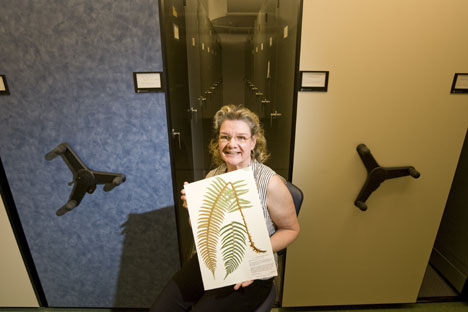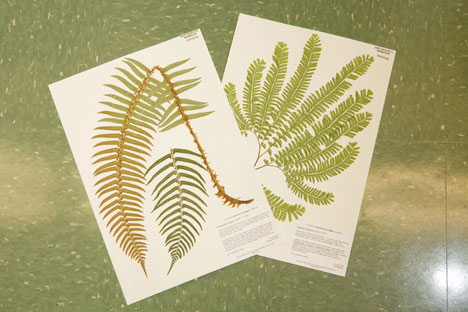
Curator Michael Windham unlocks the door to the Duke herbarium and leads a visitor into a new high-density storage facility containing more than 400,000 pressed flowering plants. Hundreds of tall storage cabinets, mounted on movable carriages, comprise a veritable library of plant life.
After being stored off campus for several years, the collection has been given a new home inside the phytotron behind the French Family Science Center.
"Having the new space is truly wonderful," said Kathleen Pryer, director of the herbarium, and associate professor in the department of biology. "With the new space, these specimens can finally be housed together under one roof, and organized and curated using modern, up-to-date approaches."
The earliest herbarium at Duke dates to Hugo L. Blomquist's arrival at Trinity College in 1921 with a collection of specimens stored in shoe boxes.
By the time Robert L. Wilbur, professor and curator emeritus, joined the Botany Department in 1957, the herbarium had roughly 130,000 vascular plant specimens. The collection continued to grow rapidly as a result of the extensive collecting activities of Wilbur, his colleagues, and their students, who mostly worked in the American Southeast, as well as the Neotropics.
As they are collected in the field, the plants are placed in a press, which dries them out. Then back at the herbarium they are glued and tied down to special acid-free sheets and placed inside folders in metal cabinets to keep them safe. Each specimen features a detailed label, which includes the plant's identity, the location where it was found, the coordinates of the location, the date of collection, and the name of the person who collected it.
Sherri Herndon, the herbarium's data manager, has been preparing vascular plant specimens for the herbarium for more than 40 years. "I started doing this in high school, working part time with Wilbur, and eventually moved on to becoming a full-time employee," Herndon said.
The specimen folders are organized within the cabinets according to a modern system of classification, so that specimens can be easily located for study. The new Phytotron herbarium facility is kept at low temperature (~65°F) and humidity (~50%) conditions to help preserve the plants and keep pesky bugs from eating them.
After Wilbur's arrival at Duke, the flowering plants collection soon outgrew its original home in the Biological Sciences, and metal herbarium cabinets began to line the hallways and stairways throughout the building, including the basement. When construction preparation began on the French Family Science Center, which is connected to BioSci on several levels, it became necessary to move more than 500 cabinets from BioSci to an off-site warehouse about 3 miles from campus.
Earlier this year, thanks to support from the National Science Foundation and Duke, the flowering plants collections moved back to campus.
"To have all our collections back on campus and in such a nice new facility is really a dream come true for us," said Pryer.
The original herbarium space in the BioSci building is now occupied by collections of non-flowering plants: algae, mosses, lichens, fungi, ferns, and gymnosperms. These plants are less susceptible to insect pests and temperature fluctuations and are better suited to the conditions in this older space.
Among the flowering plants in Duke's herbarium collection are specimens of Amborella from New Caledonia, the sister lineage to all other flowering plants. Pentagramma, a desert fern collected last year in California, recently became the vascular plant collection's 400,000th specimen.
The Duke herbarium collection will continue to grow in a targeted fashion as faculty, staff, and students take research field trips to Mexico, Nepal and Brazil and other locations in the next few months.
Early this fall, herbarium will host an open house to show off its new space.
Below, two of the pages held in the herbarium library.
